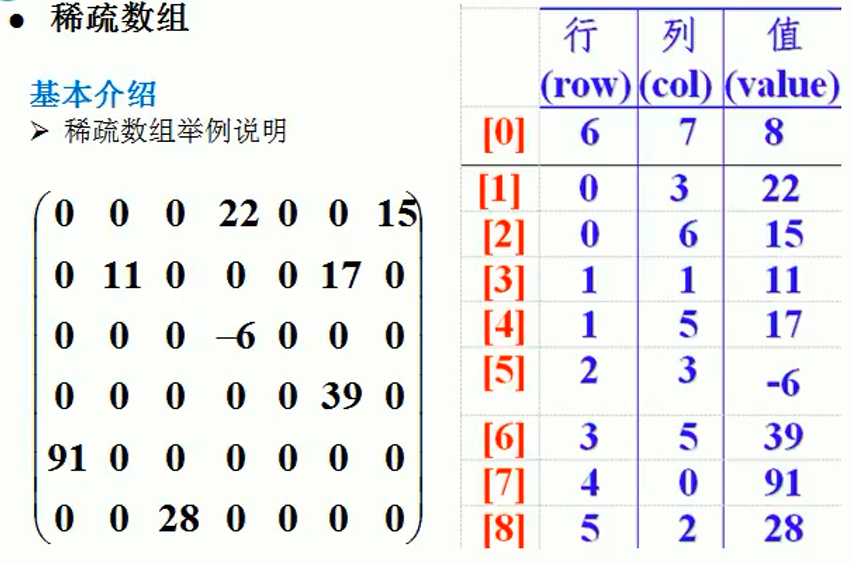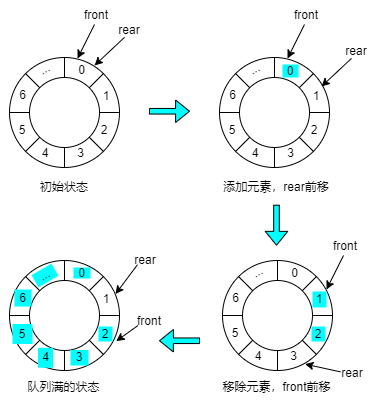稀疏数组和队列
本文最后更新于:2022年12月13日 晚上
稀疏数组和队列
稀疏数组
基本介绍
当一个数组中大部分元素为0,或者为同一个值的数组时,可以使用稀疏数组来保存该数组。
稀疏数组的处理方法是:
- 记录数组一共有几行几列,有多少个不同的值
- 把具有不同值的元素的行列及值记录在一个小规模的数组中,从而缩小程序的规模

实现思路

二维数组转稀疏数组的思路
- 遍历原始的二维数组,得到有效数据的个数sum
- 根据 sum 就可以创建稀疏数组 sparseArr int[sum+1][3]
- 将二维数组的有效数据数据存入到稀疏数组
稀疏数组转原始的二维数组的思路
- 先读取稀疏数组的第一行,根据第一行的数据,创建原始的二维数组,比如上面的 chessArr2=int[11][11]
- 再读取稀疏数组后几行的数据,并赋给原始的二维数组即可.
代码实现
public class SparseArray {
public static void main(String[] args) {
// 创建一个原始的二维数组 11*11
// 0:表示没有棋子,1 表示 黑子, 2 表示 白子
int[][] chessArr1 = new int[11][11];
chessArr1[1][2] = 1;
chessArr1[2][3] = 2;
chessArr1[5][4] = 2;
// 输出原始的二维数组
System.out.println("原始的二维数组");
for (int[] row : chessArr1) {
for (int data : row) {
System.out.printf("%d\t", data);
}
System.out.println();
}
// 将二维数组转为稀疏数组
// 1. 遍历原始的二维数组,得到有效数据的个数sum
int sum = 0;
for (int i = 0; i < 11; i++) {
for (int j = 0; j < 11; j++) {
if (chessArr1[i][j] != 0) {
sum++;
}
}
}
System.out.println(sum);
// 2. 根据 sum 就可以创建稀疏数组 sparseArr int[sum+1][3]
int[][] sparseArr = new int[sum + 1][3];
// 3. 将二维数组的有效数据数据存入到稀疏数组
sparseArr[0][0] = 11;
sparseArr[0][1] = 11;
sparseArr[0][2] = sum;
// 遍历二维数组,将非O的值存放到sparseArr中
int count = 1;
for (int i = 0; i < 11; i++) {
for (int j = 0; j < 11; j++) {
if (chessArr1[i][j] != 0) {
sparseArr[count][0] = i;
sparseArr[count][1] = j;
sparseArr[count][2] = chessArr1[i][j];
count++;
}
}
}
// 输出稀疏数组
System.out.println("稀疏数组");
for (int[] row : sparseArr) {
for (int data : row) {
System.out.printf("%d\t", data);
}
System.out.println();
}
// 将sparseArr 写入磁盘
try {
OutputStream out = new FileOutputStream("map.data");
ObjectOutputStream objectOutputStream = new ObjectOutputStream(out);
objectOutputStream.writeObject(sparseArr);
out.close();
objectOutputStream.close();
} catch (IOException e) {
e.printStackTrace();
}
// 将sparseArr 从磁盘中读取
int[][] sparseArr2 = null;
try {
InputStream in = new FileInputStream("map.data");
ObjectInputStream objectInputStream = new ObjectInputStream(in);
Object obj = objectInputStream.readObject();
sparseArr2 = (int[][]) obj;
in.close();
objectInputStream.close();
} catch (IOException | ClassNotFoundException e) {
e.printStackTrace();
}
// 稀疏数组转原始的二维数组
// 1. 先读取稀疏数组的第一行,根据第一行的数据,创建原始的二维数组,比如上面的 chessArr2=int[11][11]
assert sparseArr2 != null;
int[][] chessArr2 = new int[sparseArr2[0][0]][sparseArr2[0][1]];
for (int i = 1; i < sparseArr.length; i++) {
chessArr2[sparseArr2[i][0]][sparseArr2[i][1]] = sparseArr2[i][2];
}
System.out.println("还原的二维数组");
for (int[] row : chessArr2) {
for (int data : row) {
System.out.printf("%d\t", data);
}
System.out.println();
}
}
}队列
基本介绍
- 队列是一个有序列表,可以用数组或是链表来实现。
- 遵循先入先出的原则。即:先存入队列的数据,要先取出。后存入的要后取出
数组模拟队列
实现思路
- 队列本身是有序列表,若使用数组的结构来存储队列的数据,则队列数组的声明如下图,其中maxSize是该队列的最大容量。
- 因为队列的输出、输入是分别从前后端来处理,因此需要两个变量front及rear分别记录队列前后端的下标,front会随着数据输出而改变,而rear则是随着数据输入而改变,

当我们将数据存入队列时称为”addQueue”,addQueue的处理需要有两个步骤:
- 将尾指针往后移:rear+1,当front == rear(空)
- 若尾指针rear小于队列的最大下标maxSize-1,则将数据存入rear所指的数组元素中,否则无法存入数据。rear == maxSize-1(队列满)
代码实现
public class ArrayQueueDemo {
public static void main(String[] args) {
//创建队列
ArrayQueue arrayQueue = new ArrayQueue(3);
char key = ' '; // 接收用户·输入
Scanner scanner = new Scanner(System.in);
boolean loop = true;
// 输出菜单
while (loop) {
System.out.println("s(show): 显示队列");
System.out.println("a(add): 添加元素");
System.out.println("g(get): 取出元素");
System.out.println("h(head): 查看头部");
System.out.println("e(exit): 退出程序");
key = scanner.next().charAt(0); // 接收一个字符
switch (key) {
case 's':
arrayQueue.showQueue();
break;
case 'a':
System.out.println("输入一个数字");
int value = scanner.nextInt();
arrayQueue.addQueue(value);
break;
case 'g':
try {
int res = arrayQueue.getQueue();
System.out.println("取出的数据是" + res);
} catch (Exception e) {
System.out.println(e.getMessage());
}
break;
case 'h':
try {
int res = arrayQueue.headQueue();
System.out.println("取出的队列头数据是" + res);
} catch (Exception e) {
System.out.println(e.getMessage());
}
break;
case 'e':
scanner.close();
loop = false;
break;
default:
break;
}
}
System.out.println("程序退出");
}
}
// 使用数组模拟队列
class ArrayQueue {
private int maxSize; // 表示数组最大容量
private int front; // 队列头
private int rear; // 队列尾
private int[] arr; // 用数组模拟队列
// 创建队列的构造器,初始化队列
public ArrayQueue(int maxSize) {
this.maxSize = maxSize;
arr = new int[maxSize];
front = -1; // 指向队列头部(不包含,指向队列头的前一个位置)
rear = -1; // 指向队列尾部(包含队列最后一个数据)
}
// 判断队列是否为满
public boolean isFull() {
return rear == maxSize - 1;
}
// 判断队列是否为空
public boolean isEmpty() {
return rear == front;
}
//添加数据到队列
public void addQueue(int n) {
//判断队列是否为满
if (isFull()) {
System.out.println("该队列已满,无法添加数据");
return;
}
rear++; // rear后移
arr[rear] = n;
}
//获取队列的数据,出队列
public int getQueue() {
if (isEmpty()) {
//抛出异常
throw new RuntimeException("队列空,无法取出数据");
}
front++;
return arr[front];
}
//显示队列所有数据
public void showQueue() {
if (isEmpty()) {
//抛出异常
throw new RuntimeException("队列空,无法取出数据");
}
//遍历
for (int i = 0;i<arr.length;i++) {
System.out.printf("arr[%d]=%d\n", i,arr[i]);
}
}
//显示队列的头数据,注意不是取出数据
public int headQueue() {
if (isEmpty()) {
//抛出异常
throw new RuntimeException("队列空,无数据");
}
return arr[front + 1];
}
}存在问题
目前数组使用一次就不能用,没有达到复用的效果
优化思路
将这个数组使用算法改进成一个环形的数组
数组模拟环形队列
思路分析
- front变量的含义:front就指向队列的第一个元素,也就是说
arr[front]就是队列的第一个元素,front的初始值=0 - rear变量的含义:rear指向队列的最后一个元素的后一个位置,因为需要空出一个空间做为约定,rear的初始值=0
- 当队列满时,条件是
(rear+1)%maxSize=front - 对队列为空的条件是
rear=front - 队列中有效的数据的个数
(rear+maxSize-front)%maxSize

代码实现
public class CircleQueueDemo {
public static void main(String[] args) {
CircleQueue circleQueue = new CircleQueue(6);
char key = ' '; // 接收用户·输入
Scanner scanner = new Scanner(System.in);
boolean loop = true;
// 输出菜单
while (loop) {
System.out.println("s(show): 显示队列");
System.out.println("a(add): 添加元素");
System.out.println("g(get): 取出元素");
System.out.println("h(head): 查看头部");
System.out.println("e(exit): 退出程序");
key = scanner.next().charAt(0); // 接收一个字符
switch (key) {
case 's':
circleQueue.showQueue();
break;
case 'a':
System.out.println("输入一个数字");
int value = scanner.nextInt();
circleQueue.addQueue(value);
break;
case 'g':
try {
int res = circleQueue.removeQueue();
System.out.println("取出的数据是" + res);
} catch (Exception e) {
System.out.println(e.getMessage());
}
break;
case 'h':
try {
int res = circleQueue.headQueue();
System.out.println("取出的队列头数据是" + res);
} catch (Exception e) {
System.out.println(e.getMessage());
}
break;
case 'e':
scanner.close();
loop = false;
break;
default:
break;
}
}
System.out.println("程序退出");
}
}
class CircleQueue {
private int front;
private int rear;
private int maxSize;
private int[] arr;
// 初始化环形数组
public CircleQueue(int maxSize) {
this.maxSize = maxSize;
arr = new int[maxSize];
front = 0;
rear = 0;
}
public boolean isFull() {
return (rear + 1) % maxSize == front;
}
public boolean isEmpty() {
return rear == front;
}
public void addQueue(int num) {
if (isFull()) {
System.out.println("队列已满,无法添加");
return;
}
arr[rear] = num;
// if (rear < maxSize - 1) {
// rear++;
// } else {
// rear = 0;
// }
rear = (rear + 1) % maxSize;
}
public int removeQueue() {
if (isEmpty()) {
System.out.println("队列为空,无法出队");
return -1;
}
int res = arr[front];
// if (front < maxSize - 1) {
// front++;
// } else {
// front = 0;
// }
front = (front + 1) % maxSize;
return res;
}
//显示队列所有数据
public void showQueue() {
if (isEmpty()) {
System.out.println("队列为空,无法显示所有数据");
return;
}
//遍历
for (int i = front; i < front + getSize(); i++) {
System.out.printf("arr[%d]=%d\n", i % maxSize, arr[i % maxSize]);
}
}
public int headQueue() {
if (isEmpty()) {
System.out.println("队列为空,无法获取头部");
return -1;
}
return arr[front];
}
public int getSize() {
return (rear + maxSize - front) % maxSize;
}
}稀疏数组和队列
https://yorick-ryu.github.io/数据结构/数据结构_稀疏数组和队列/